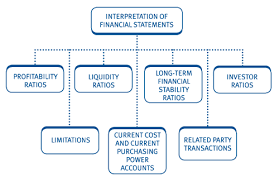How and Different Ways to Interpret Financial Statements
An ability to understand the financial health of a company is one of the most vital skills for aspiring investors, entrepreneurs, and managers to develop.
Armed with this knowledge, investors can better identify promising opportunities while avoiding undue risk, and professionals of all levels can make more strategic business decisions.
Financial statements offer a window into the health of a company, which can be difficult to gauge using other means.
While accountants and finance specialists are trained to read and understand these documents, many business professionals are not. The effect is an obfuscation of critical information.
Financial statements are written records that convey the business activities and the financial performance of a company. Financial statements are often audited by government agencies, accountants, firms, etc. to ensure accuracy and for tax, financing, or investing purposes. Financial statements include:
- Balance sheet
- Income statement
- Cash flow statement.
Financial Statements
Investors and financial analysts rely on financial data to analyze the performance of a company and make predictions about its future direction of the company’s stock price. One of the most important resources of reliable and audited financial data is the annual report, which contains the firm’s financial statements.
The financial statements are used by investors, market analysts, and creditors to evaluate a company’s financial health and earnings potential. The three major financial statement reports are the balance sheet, income statement, and statement of cash flows.
- Financial statements are written records that convey the business activities and the financial performance of a company.
- The balance sheet provides an overview of assets, liabilities, and stockholders’ equity as a snapshot in time.
- The income statement primarily focuses on a company’s revenues and expenses during a particular period. Once expenses are subtracted from revenues, the statement produces a company’s profit figure called net income.
- The cash flow statement (CFS) measures how well a company generates cash to pay its debt obligations, fund its operating expenses, and fund investments.
The balance sheet provides an overview of a company’s assets, liabilities, and stockholders’ equity as a snapshot in time. The date at the top of the balance sheet tells you when the snapshot was taken, which is generally the end of the fiscal year.
Assets = (Liabilities + Owner’s Equity)
The balance sheet totals will be calculated already, but here’s how you identify them.
- Locate total assets on the balance sheet for the period.
- Total all liabilities, which should be a separate listing on the balance sheet. It may not include contingent liabilities.
- Locate total shareholder’s equity and add the number to total liabilities.
- Total assets should equal the total of liabilities and total equity.
The balance sheet identifies how assets are funded, either with liabilities, such as debt, or stockholders’ equity, such as retained earnings and additional paid-in capital. Assets are listed on the balance sheet in order of liquidity.
Read Also: Essential Guide To Business Process Mapping
Liabilities are listed in the order in which they will be paid. Short-term or current liabilities are expected to be paid within the year, while long-term or noncurrent liabilities are debts expected to be paid in over one year.
Below are examples of items listed on the balance sheet.
- Cash and cash equivalents are liquid assets, which may include Treasury bills and certificates of deposit.
- Accounts receivables are the amount of money owed to the company by its customers for the sale of its product and service.
- Inventory
- Shareholders’ equity is a company’s total assets minus its total liabilities. Shareholders’ equity represents the amount of money that would be returned to shareholders if all of the assets were liquidated and all of the company’s debt was paid off.
- Retained earnings are part of shareholders’ equity and are the amount of net earnings that were not paid to shareholders as dividends.
- Total assets were $354,628 (highlighted in green).
- Total liabilities were $157,797 (1st red highlighted area).
- Total equity was $196,831 (in red).
- Total liabilities and equity were $354,628, which equals the total assets for the period.
Unlike the balance sheet, the income statement covers a range of time, which is a year for annual financial statements and a quarter for quarterly financial statements.
The income statement provides an overview of revenues, expenses, net income and earnings per share. It usually provides two to three years of data for comparison.
Net Income = (Revenue − Expenses)
- Total all revenue or sales for the period.
- Total all expenses and costs of operating the business.
- Subtract total expenses from revenue to achieve net income or the profit for the period.
An income statement is one of the three important financial statements used for reporting a company’s financial performance over a specific accounting period.
Also known as the profit and loss statement or the statement of revenue and expense, the income statement primarily focuses on a company’s revenues and expenses during a particular period.
Once expenses are subtracted from revenues, the statement produces a company’s profit figure called net income.
Operating revenue is the revenue earned by selling a company’s products or services. The operating revenue for an auto manufacturer would be realized through the production and sale of autos. Operating revenue is generated from the core business activities of a company.
Non-operating revenue is the income earned from non-core business activities. These revenues fall outside the primary function of the business. Some non-operating revenue examples include:
- Interest earned on cash in the bank
- Rental income from a property
- Income from strategic partnerships like royalty payment receipts
- Income from an advertisement display located on the company’s property
Other income is the revenue earned from other activities. Other income could include gains from the sale of long-term assets such as land, vehicles, or a subsidiary.
Primary expenses are incurred during the process of earning revenue from the primary activity of the business. Expenses include the cost of goods sold (COGS), selling, general and administrative expenses (SG&A), depreciation or amortization, and research and development (R&D). Typical expenses include employee wages, sales commissions, and utilities such as electricity and transportation.
Expenses that are linked to secondary activities include interest paid on loans or debt. Losses from the sale of an asset are also recorded as expenses.
The main purpose of the income statement is to convey details of profitability and the financial results of business activities. However, it can be very effective in showing whether sales or revenue is increasing when compared over multiple periods.
Read Also: How to and Importance of Building a Successful Business Team
Investors can also see how well a company’s management is controlling expenses to determine whether a company’s efforts in reducing the cost of sales might boost profits over time.
- Total revenues were $76,605 for the period.
- Total costs were $67,525.
- Net income or profit was $6,240.
The cash flow statement (CFS) measures how well a company generates cash to pay its debt obligations, fund its operating expenses, and fund investments. The cash flow statement complements the balance sheet and income statement.
The CFS allows investors to understand how a company’s operations are running, where its money is coming from, and how money is being spent. The CFS also provides insight as to whether a company is on a solid financial footing.
There is no formula, per se, for calculating a cash flow statement, but instead, it contains three sections that report the cash flow for the various activities that a company has used its cash. Those three components of the CFS are listed below.
The operating activities on the CFS include any sources and uses of cash from running the business and selling its products or services. Cash from operations includes any changes made in cash, accounts receivable, depreciation, inventory, and accounts payable.
These transactions also include wages, income tax payments, interest payments, rent, and cash receipts from the sale of a product or service.
Investing activities include any sources and uses of cash from a company’s investments into the long-term future of the company. A purchase or sale of an asset, loans made to vendors or received from customers or any payments related to a merger or acquisition is included in this category.
Also, purchases of fixed assets such as property, plant, and equipment (PPE) are included in this section. In short, changes in equipment, assets, or investments relate to cash from investing.
Cash from financing activities include the sources of cash from investors or banks, as well as the uses of cash paid to shareholders. Financing activities include debt issuance, equity issuance, stock repurchases, loans, dividends paid, and repayments of debt.
The cash flow statement reconciles the income statement with the balance sheet in three major business activities.
Read Also: The Definition Types and Importance of Finance
We can see the three areas of the cash flow statement and their results.
- Operating activities generated a positive cash flow of $27,407 for the period.
- Investing activities generated negative cash flow or cash outflows of -$10,862 for the period. Additions to property, plant, and equipment made up the majority of cash outflows, which means the company invested in new fixed assets.
- Financing activities generated negative cash flow or cash outflows of -$13,945 for the period. Reductions in short-term debt and dividends paid out made up the majority of the cash outflows.
Although financial statements provide a wealth of information on a company, they do have limitations. The statements are open to interpretation, and as a result, investors often draw vastly different conclusions about a company’s financial performance.
For example, some investors might want stock repurchases while other investors might prefer to see that money invested in long-term assets. A company’s debt level might be fine for one investor while another might have concerns about the level of debt for the company.
When analyzing financial statements, it’s important to compare multiple periods to determine if there are any trends as well as compare the company’s results its peers in the same industry.




